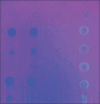Extraction and Analysis of Antimicrobial Compounds from Onosma Bracteatum Using Response Surface Methodology
- PMID: 40510997
- PMCID: PMC12156613
- DOI: 10.4103/jpbs.jpbs_1595_24
Extraction and Analysis of Antimicrobial Compounds from Onosma Bracteatum Using Response Surface Methodology
Abstract
Background: Infectious diseases are the world's leading cause of premature mortality, almost killing 65,000 people every day.
Objective: The main objective of the study is to find the extraction and analysis of antimicrobial compounds from Onosma Bracteatum using response surface methodology.
Materials and methods: ATCC culture samples and antibiotic discs were purchased from PCSIR and scientific markets. All chemicals with reagents of analytical and commercial grades were purchased from Sigma Millipore Chemical Germany, Daejung Chemicals, China, and Unichem England. ONOSMA BRACTEATUM was purchased from the herbal market and its extracts were prepared in the lab.
Results: The plant extracts; ONO (3.82%) having light green color were arranged and further valued by performing phytochemical analysis of plant extracts. The highest quantity of phenolic content was observed in Ethanolic, Chloroform, and n-hexane extract of fruit with values 97.0 ± 0.91, 39.5 ± 0.55, and 8.1 ± 0.67 μg GAE/mg extract respectively.
Conclusion: It very well might be deduced from this research that in-vitro investigation of the O. bracteatum plant showed a critical zone of inhibition against Escherichia coli, Bacillus subtilis, Staph aureus, klebsiella pneumonia, and Pseudomonas aeruginosa.
Keywords: Antimicrobials; Onosma bracteatum; response surface methodology.
Copyright: © 2025 Journal of Pharmacy and Bioallied Sciences.
Conflict of interest statement
There are no conflicts of interest.
Figures


Similar articles
-
Evaluation of the phenolic contents and antibacterial activity of different concentrations of Onosma chlorotricum Boiss.BioTechnologia (Pozn). 2021 Dec 22;102(4):377-386. doi: 10.5114/bta.2021.111095. eCollection 2021. BioTechnologia (Pozn). 2021. PMID: 36605600 Free PMC article.
-
Phytochemical screening, HPLC analysis, antimicrobial and antioxidant effect of Euphorbia parviflora L. (Euphorbiaceae Juss.).Sci Rep. 2024 Mar 7;14(1):5627. doi: 10.1038/s41598-024-55905-w. Sci Rep. 2024. PMID: 38454096 Free PMC article.
-
Antibacterial Activity of Economically Important Medicinal Plants in Pakistan Against Different Bacterial Strains.Bioinform Biol Insights. 2023 Jul 31;17:11779322231189374. doi: 10.1177/11779322231189374. eCollection 2023. Bioinform Biol Insights. 2023. PMID: 37533430 Free PMC article.
-
[Antimicrobial activity of soft and purified propolis extracts].Medicina (Kaunas). 2008;44(12):977-83. Medicina (Kaunas). 2008. PMID: 19142056 Lithuanian.
-
Onosma bracteatum Wall Aqueous-Ethanolic Extract Suppresses Complete Freund's Adjuvant-Induced Arthritis in Rats via Regulation of TNF-α, IL-6, and C-Reactive Protein.Molecules. 2024 Apr 17;29(8):1830. doi: 10.3390/molecules29081830. Molecules. 2024. PMID: 38675650 Free PMC article.
References
-
- Shen CC, Syu WJ, Li SY, Lin CH, Lee GH, Sun CM. Antimicrobial activities of naphthazarins from Arnebia euchroma. J Nat Prod. 2002;65:1857–62. - PubMed
-
- Papageorgiou VP, Assimopoulou AN, Ballis AC. Alkannins and shikonins: A new class of wound healing agents. Curr Med Chem. 2008;15:3248–67. - PubMed
-
- Nishizawa M, Kohno M, Nishimura M, Kitagawa A, Niwano Y. Presence of peroxyradicals in cigarette smoke and the scavenging effect of shikonin, a naphthoquinone pigment. Chem Pharm Bull. 2005;53:796–9. - PubMed
LinkOut - more resources
Full Text Sources
Miscellaneous
